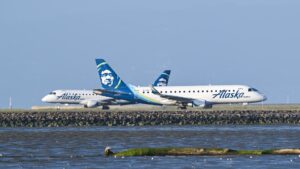Alaska Airlines on the Rise: Bold Moves for a Billion-Dollar Profit Surge
Welcome to Extreme Investor Network, where we keep our finger on the pulse of the business world, unraveling news that can shape your investment strategies. Today, we dive into the latest developments from Alaska Airlines, an airline poised for significant expansione. As we analyze Alaska Airlines’ ambitious growth plans and strategic initiatives, prepare to discover insights that may just make you look twice at your investment portfolio.
Major Growth Ahead: $1 Billion Profit Target by 2027
Alaska Airlines is making waves in the travel industry, setting its sights on an extraordinary $1 billion profit increase by 2027. The catalyst behind this growth? A rising demand for high-end travel. With a robust strategy targeting affluent travelers, Alaska Airlines is ready to ride the wave of this booming market.
In a game-changing move, Alaska closed its $1.9 billion acquisition of Hawaiian Airlines this past September. This acquisition not only strengthens its route network but also brings into play the wide-body aircraft capabilities of the Boeing 787 Dreamliner, significantly enhancing its operational efficiency. Although the two airline brands will continue to operate separately, integrating Hawaiian Airlines’ offerings is expected to provide a competitive edge in Pacific routes.
Expanding International Reach
Alaska Airlines has unveiled a series of new routes that underscore its commitment to becoming a major player on the international stage. Starting in May 2024, travelers can look forward to nonstop service connecting Seattle-Tacoma International Airport to Tokyo’s Narita International Airport. By October, the route will extend to Incheon International Airport in Seoul, South Korea. This expansion is part of an ambitious plan to serve a minimum of a dozen international destinations from Seattle by 2030, using wide-body aircraft for enhanced passenger comfort.
Aiming for Stronger Financial Metrics
Alaska Airlines is not just focused on expanding its routes. The airline profits are projected to reflect robust growth, with pretax margins expected to range between 11% and 13% by 2027. Furthermore, analysts forecast per-share earnings could exceed $10, which investors should watch closely. For the immediate future, the airline estimates 2024 earnings between $3.50 and $4.50 per share, including contributions from Hawaiian Airlines.
New Ventures in Premium Offerings
As part of its strategic initiative, Alaska Airlines plans to introduce a new "premium" credit card in partnership with Bank of America, aimed at capturing revenue streams from customers even when they aren’t flying. This move aligns with the airline’s focus on enhancing its premium offerings and addressing the growing trend of travelers willing to pay for elevated experiences.
Chief Financial Officer Shane Tackett noted that there has been a significant uptick in demand for premium seats, with more travelers opting to purchase their first-class or premium economy tickets outright rather than relying on complimentary upgrades. Alaska Airlines is set to roll out improvements across its fleet, particularly targeting its Airbus A330 aircraft, emphasizing comfort and enhanced service.
Staying Competitive in a Crowded Market
Competition is fierce in the airline industry. With Delta Air Lines maintaining a strong presence in Seattle and capitalizing on its larger share of international travelers, Alaska Airlines must continuously evolve its offerings. The company plans to stay ahead by investing in customer-centric enhancements, including the development of a new lounge at San Diego International Airport—a strategic move to cater to its premium clientele.
Navigating Challenges with Boeing
Amid these ambitious growth plans, Alaska Airlines faces challenges related to aircraft deliveries from Boeing. Recent issues with aircraft quality have led to slowed output and deliveries, which Tackett noted require careful management and collaboration with the manufacturer. As Alaska works through these delivery challenges, keeping a close watch on Boeing’s performance could provide investors with insight on Alaska’s operational capabilities.
Conclusion: A Bright Future for Alaska Airlines
With a strategic acquisition, ambitious international expansion projects, and a keen eye on premium service development, Alaska Airlines is setting the stage for significant growth in the coming years. At Extreme Investor Network, we believe this airline’s proactive approach, combined with favorable market dynamics, positions it as an intriguing option for investors looking to diversify their portfolios in the travel sector.
Stay tuned to Extreme Investor Network for more insights and analysis on the latest trends affecting your investment strategies.

